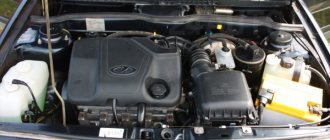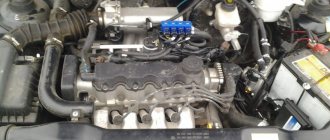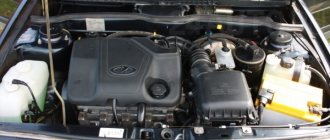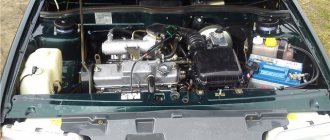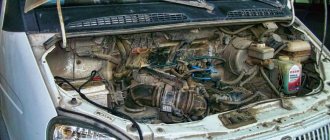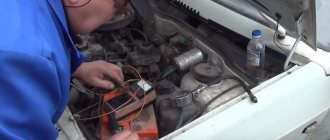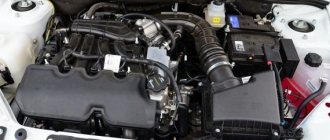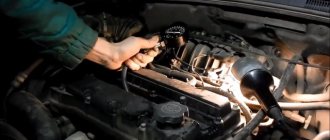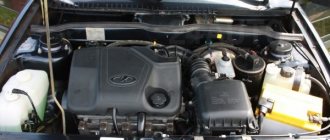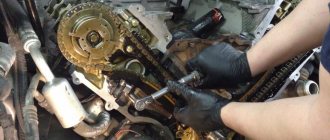Lada Granta engine starts when cold
It is worth noting that the causes of malfunctions are similar for all modern Lada cars (Kalina, Granta, Priora, Largus, Vesta, Niva or XRAY), because AvtoVAZ equips them with engines with identical characteristics.It is recommended to start searching for a problem with diagnostics (reading errors). If this is not possible, then we first perform a test (or temporarily install a known working spare part/sensor), and only then replace the faulty parts.
If the engine idles or the car jerks when accelerating (driving), possible reasons:
Why does “triple” occur on Kalina
It is easy to understand that the reasons for such a malfunction in Lada Kalina can be varied. To correctly and quickly determine the cause of the tripping, it is necessary to determine which cylinder is faulty. Experts advise starting the search as soon as the check light comes on. After all, it was not without reason that the model manufacturer installed an automatic warning system in the car.
You don’t have to spend a lot of time and effort to detect a faulty cylinder. It is necessary to disconnect the so-called power tips from the spark plugs one by one. By carrying out this procedure, you can determine by the sound of the engine which cylinder is not working. If the sound of the engine has changed, it means that you have discovered the cause of the “triple”.
When LADA Kalina indicates a problem in the power plant with a burning check, you can perform computer diagnostics, and quickly, without effort on your part, the computer will tell you which cylinder is faulty. With the help of computer diagnostics, you can identify the original cause that led to the malfunction of the unit. There are many reasons, these could be:
- Using spark plugs that are not suitable for this engine;
- The ignition timing is incorrect;
- The air filter is dirty;
- There is an air leak in the vacuum booster of the brake system;
- The carburetor is poorly adjusted;
- The spark plugs are defective;
- The valve stem seals are badly worn;
- Condenser wires or electrical wiring are broken;
- The gas distribution phases are incorrect;
- Piston rings are broken or worn;
- The cylinder head has defects;
- There is air in the exhaust manifold;
- Valves and pistons burned out.
When one of the LADA Kalina cylinders fails, in most cases the problem lies in the spark plugs that have failed. Then it happens that the engine stalls when cold. But the malfunction of the spark plugs, or rather their failure, lies in a poorly warmed-up engine, especially in the morning.
Other reasons for unstable engine operation Grants
Floating speeds and tripping are not the only problems associated with the functioning of the Lada Granta engine. There are other situations.
Engine does not develop power
This problem is not relevant if the car is new and is being run-in. Until 5 or 8 thousand kilometers, the engine should not gain maximum power. And for the first 2 thousand kilometers, it is not at all recommended to raise the tachometer needle above the 3000 rpm mark.
It happens that when accelerating a car:
- does not gain the required power;
- moves as if there is a trailer behind it;
- When accelerating it sticks.
These are signs of low pressure in the fuel system. It is recommended to replace the fuel filter with a new one. The cause may also be low-quality gasoline. The Grant is equipped with an electronic gas pedal - its malfunction can also cause insufficient engine power.
Other engine and system malfunctions
- Compression in the engine cylinders is low.
- The cylinder head gasket is damaged.
- The engine control system is faulty.
- The valves of the gas distribution mechanism are burnt out and leaky.
- The exhaust system is leaking.
- The valve clearances are not adjusted (8-valve engines only).
- The hydraulic pushers are faulty.
- The engine air filter is dirty.
- Vacuum hose connections are leaking.
Have you encountered power failures or observed unstable engine operation? What was the reason? We solve similar power unit problems in the comments or on the forum. Let us remind you that along with misfires, other engine malfunctions may appear, for example, floating speed.
Share on social networks:
Found an error? Select it and press Ctrl+Enter..
The engine stalls, the check light flashes or lights up: the main reasons
Let's start with the fact that injection engines are equipped with special catalyst devices for cleaning the exhaust. At the same time, the catalytic converter is a rather vulnerable and at the same time expensive element, and all sorts of malfunctions in the engine create a risk of damage.
As a rule, the check flashes when there is a risk of damage to the catalyst. In this case, the simultaneous tripping of the engine means that one or more cylinders are not working or are not working correctly. In practice, this means that the fuel in the problem cylinder does not burn completely, after which it enters the exhaust system.
As a result, the remaining unburnt fuel burns out in the area where the catalyst is located, since the temperatures there are very high. Fuel also gets on the catalyst itself, causing it to fail.
It becomes clear that the check often lights up when problems arise with the combustion of the mixture in the cylinders. It is not difficult to guess that such combustion can be disrupted for a number of reasons, ranging from problems with
ignition system
or fuel supply and ending with lack of intake air,
air leak
,
reduced compression
in the engine cylinder, etc.
It should be added that the check also often lights up in the event of failure of any ECM sensors. One way or another, it is quite obvious that the “check” in the vast majority of cases indicates either problems with the electronic engine control system itself, or the risk of damage to the catalyst due to malfunctions of the internal combustion engine.
It is important to understand that the engine tripping indicates a non-functioning cylinder. In this case, the check is flashing not due to the failure of any ECM sensor, malfunction of the exhaust gas recirculation system or poor fuel in the tank, but rather signals to the driver about a direct threat to the catalyst.
In a nutshell, fuel that is not burned and gets into the outlet causes a special sensor (lambda probe, oxygen sensor) to send readings to the ECU indicating deviations from the norm. The control unit begins to try to correct the situation, but taking into account the tripping, it is simply not able to adjust the operation of the motor so that everything returns to normal. As a result, fuel consumption increases, while the engine operates unstably, idle speed fluctuates, etc. In some cases, the motor “falls” into emergency mode.
This mode is necessary in order to minimize damage to the catalyst and the internal combustion engine itself. In practice, this is expressed in such a way that although the driver presses on the gas, the car in emergency mode with the “check” on still does not accelerate above 30-40 km/h, the crankshaft does not spin up, engine traction disappears, etc.
This feature of engine operation is primarily aimed at preventing burnout or melting of the catalyst. The catalyst itself consists of small honeycomb cells. If unburned fuel intensively enters the exhaust and burns out in the catalyst, the element will simply melt.
This melting will lead to the fact that exhaust gases will not be able to pass normally through the catalyst, that is, a plug appears in the exhaust pipe. Naturally, the engine will “suffocate”, power will drop, the engine may not start at all, etc.
Also, the catalyst will no longer be able to clean the exhaust, and toxicity will increase. There is only one way out in this situation - repairing the engine to eliminate the main cause of the engine tripping, and only then replacing the expensive catalyst with a new one. To minimize risks, a special program is programmed into the ECU, which involves operating the engine in emergency mode.
Engine diagnostics
Before you start tinkering with the hardware, it’s worth turning to the car’s software and understanding whether the reason may lie in the failure of one of the power unit’s sensors or in a so-called software failure.
Getting access to the car's software is quite simple. To do this, the motorist will need some equipment and materials. First, you should find out which engine control unit is installed on the vehicle.
To do this, you need to look at the service documentation or decipher the body number. The second option is not available to everyone, and therefore it is worth following the path of the slightest resistance. Electronic engine control units marked 11186-1411020-12 can be installed on the Lada Kalina 2 power unit.
Diagnostics Lada Kalina 2.
Depending on which ECU is installed on the car, it is worth choosing software for diagnosing and repairing software. Also, in the process you cannot do without a USB data cable, which is called OBD II. Well, to perform direct diagnostics and guide the process - a laptop computer or tablet.
Let's proceed directly to the process of diagnostics and troubleshooting. We install the appropriate program on the tablet, which will not only allow it to synchronize with the ECU, but will also make it possible to carry out full diagnostics. After installing the software, connect the cable to the tablet and control unit.
By analyzing the data obtained, you can understand what the condition of the equipment is and whether there are problems. Typically, diagnostics show failed sensors that need to be replaced. After replacement, it is worth clearing the accumulated errors and trying to see if the engine operation has changed. If this does not happen and the cause remains, then you should go directly to looking for the causes in the hardware.
Sometimes there are cases when the engine only starts “cold” or “hot”
In this case, the valves are most often the cause; they may have become misadjusted. Valve adjustments should be carried out every 20 thousand km. The essence of this problem is that most likely the valves have large gaps, but after the engine warms up they become smaller and the engine does not leak. The same applies to “hot” conditions - when the engine is cold, the valves are normal and the engine is running smoothly, but after warming up, the unregulated valve is clamped, as a result, the cylinder stops working and the engine begins to stall.
I will end here, I hope my article was useful to you and you found the reason for the engine tripping. If not, seek help from specialists. If you know other reasons for engine tripping, I’ll be happy to hear them, use the comment form.
Diagnosis of uneven operation in cold conditions
The main problem in troubleshooting is that the engine can stall for a short time. This moment needs to be caught and the reason found. This is especially true when the car is checked at a car service center. The car needs to be left overnight so that the diagnosticians can look at it when it’s cold. Otherwise, when it’s hot, when the engine is running normally, it will be difficult to find the cause.
Engine mechanics
First of all, you need to measure the compression on a cold engine. The indicator should not differ from the standard value for this type of motor. As a rule, for common naturally aspirated gasoline engines, 12-13 atm is considered the norm. If the indicator differs by 1-2 atm, you should think about a problem in the engine mechanics itself.
If the difference in compression is no more than 1-2 atm, you need to measure the thermal clearances of the valves when manually adjusting the gas distribution mechanism (GRM).
If the design provides for automatic adjustment due to hydraulic compensators, pay attention to the knocking noise from the valve mechanism. If the sound disappears while warming up, remove the hydraulic compensators and check their functionality.
The initial check of the hydraulics is carried out on the engine, with the valve cover removed. Without removing the camshaft, put the cams in the upper position so that there is no pressure on the valve to put pressure on the hydraulic compensator. It shouldn't be pressed. Otherwise, replace or wash.
In case of low compression, check with oil, if the indicator increases, it’s all about the piston group. If there is a slight increase in compression, repair the cylinder head. When oil gets on leaking piston rings, it closes the micron gaps and the pressure increases.
One type of mechanical damage is a broken cylinder head gasket. Depending on where the gasket burns out, coolant will leak out, get into the oil, oil will leak out, or get back into the antifreeze. If it breaks between the cylinders, compression will be lost.
The most expensive problem is a crack in the cylinder head and short block. Difficult to detect and expensive to eliminate. Metal expands and contracts depending on temperature, so the engine can start running when it’s cold.
A problem with engine mechanics is the most common cause of cold stalling.
Injector condition when cold
The second and very significant problem of modern engines is the quality of the fuel that we fill every day at gas stations. The disadvantages are not even the quality of the gasoline itself, but the presence of water and condensate. Moisture enters the filling tanks underground from groundwater, rain and is formed due to condensation. It comes in huge quantities. When the pump takes in gasoline, it captures and pumps it all into our tanks. What to do in such a situation.
It is necessary to constantly carry out preventive maintenance of the fuel system: washing the injectors every 30,000 km and pouring pure alcohol into the tank in the amount of 350-500 grams per 20-30 liters of gasoline.
On a cold engine, a dirty injector does not provide the correct spray and volume of fuel into the combustion chamber. Accordingly, the fuel-air mixture violates its proportions and does not ignite. The injector system cannot cope, as a result the engine begins to stall when starting. As it warms up, the water in the injector nozzle leaves and the engine runs smoothly.
Air leaks
A common type of malfunction when cold. The rubber bands on the injectors and the intake manifold gaskets compress with cold and allow excess air to pass through, which leads to a violation of the stoichiometric composition of the mixture. It is practically impossible to ignite such a mixture, since there is a sharp increase in the volume of oxygen molecules. And, as we know from physics courses, it is very difficult to spark a spark through these molecules.
You need to check the air leaks with a smoke generator. Diagnosticians at car repair shops have them. You can make a homemade device from plastic bottles and cigarettes. There is a lot of information about them on the Internet. You need to check air leaks when the engine is cold.
Finding the cause of the malfunction
The engine starts to stall when the fuel pump malfunctions and does not pump in the required amount of fuel, or when it does not burn completely. The substrate of the first case is not only the fuel pump itself, but also the conductive system. And the second reason may be related to problems with the ignition system, spark plug carbon, or improper operation of the engine valves.
If the fuel system is not working properly
, the feeling that the engine is stalling will develop a minute after the start, and then will only increase. If there is a narrowing of the pipeline, or there is no power to the fuel pump, such problems are not uncommon. You can check this after exposing the relay: start the engine, check the functionality of the pump and relay. In this case, the on-board computer will not show errors.
If there is a problem in the valve apparatus itself, in the spark plugs or in the ignition system, it will also manifest itself. Namely: the engine will start normally, but a moment later it will start to stall. Similarly, the power unit fault light should light up, because standard sensors perceive an excess (or lack) of fuel.
Read more: Where is the Skoda Superb assembled?
When such interruptions in the fuel supply occur, twitching develops, because the amount of gases produced in different engine operating cycles varies.
What is engine tripping?
When the check light comes on, the power unit may operate unstably. The automatic transmission handle jerks. The engine stalls and has to be started again. These problems can arise due to various malfunctions with the internal parts of the engine.
A malfunction signal is sent to the engine electronic device unit or, simply, a computer. Where it is read by the brain and sent to the dashboard screen. The driver sees this signal and must take certain corrective actions.
Attention! When a check appears in a car with an eight-valve or sixteen-valve engine, you need to go to a service center to have the vehicle inspected. Further delay leads to discarding the unit and purchasing a new one.
If the engine still stalls when the check lamp comes on, this indicates the following engine malfunctions:
- possible damage to the catalyst;
- improper operation of valves or cylinders;
- fuel combustion occurs incorrectly;
- The ignition system is faulty.
These are only part of the reasons why the engine may stall. We will look at others in the next block. In any case, experienced mechanics do not recommend fixing the problem with the check on your own. Especially if the driver simply resets the check through the battery. Such a reset leads to such an outcome that all errors in the engine brain are reset to zero. And it is more difficult for experienced mechanics to find a breakdown in the engine.
Unstable engine operation
If the engine runs unstably and stalls when idling, then there are reasons for this. It is quite possible that we are talking about insufficient pressure in the ramp. We also talk about the difficulties in the functioning of the electronic gas pedal.
In the first case, it is worth checking the pressure regulator. Just keep in mind that in new Lada Granta models this regulator may be located in conjunction with the fuel pump. As for the second situation, the check should concern the electronic part of the car, including the power unit adjustment system.
Air supply problems
The problem may also be that there is an air leak in the system. It may be located on the crankcase ventilation hose that connects the inlet pipe to the brake booster. You should carry out additional tightening of the fastening clamps. And, if the need arises, the hoses must be replaced with new ones.
If the problem concerns violation of valve clearances, then the solution requires contacting a service station.
If you own a Granta with an 8-valve engine, it is worth adjusting the timing valves every twenty thousand kilometers.
Or it could be different. If the air filter is clogged, it will be more difficult for air to get through and an overly rich mixture will flow into the injectors. In this case, diagnostics and replacement of the air filter is necessary.
Spark plug
The problem could be the spark plugs.
And, of course, the reason may relate to a malfunction of the ignition system. We are talking about the source of the problem in the form of spark plugs or individual coils. If you have localized the source of the breakdown, then the faulty part must be replaced. On 16-valve engines, AU17D spark plugs are installed from the factory.
Reasons for tripling
If the “check” is flashing on a VAZ car and the engine is shaking, this may indicate the following problems:
- Presence of air leaks in the brake system (possible problems with the vacuum booster).
- Failures in adjusting the ignition timing.
- Faulty spark plugs.
- Violation of the integrity of the high-voltage wire.
- Ignition coil malfunction.
- The air filter is clogged (the engine simply does not have enough oxygen).
- Violation of carburetor adjustments (applies to older cars).
- Failures in adjusting the gas distribution mechanism.
Among the more serious problems that cause the “check” to flash and the engine to stall, we can highlight:
- Worn intake or exhaust valve. This could be a burnout or mechanical deformation of the plate.
- Intake manifold leakage.
- Wear of valve stem seals (in this case, the engine consumes about one liter of oil per thousand kilometers).
Elimination methods
To eliminate the tripping effect on a vehicle, you need to have enough time, since it may take a whole day, as well as tools. To work, you will need a set of wrenches, screwdrivers and heads, as well as a multimeter. So, let's look at how to troubleshoot problems that have arisen.
Low quality fuel
Many experienced Kalinovods on the forums describe what is happening to the Kalina engine as the use of low-quality fuel. It is because of this that the “Check Engine” warning light on the dashboard may light up.
The on-board computer recognizes a poor-quality mixture by the combustion process. But that's not the worst thing. Poor quality gasoline can clog elements throughout the system. The consequence of long-term use of this type of fluid can lead to the valve mechanism, as well as the pistons, burning out. In this case, major repairs become inevitable, since parts wear out at an accelerated rate.
If it is discovered that the gasoline is of poor quality, the motorist will face a whole range of repair operations, namely:
- Cleaning the fuel tank and replacing the filter.
- Cleaning or changing spark plugs.
- Dismantling and checking injectors.
- And finally, disassembling the cylinder head.
After cleaning, you need to fill it with high-quality gasoline and drive it. The CHECK icon should turn off on its own when high-quality fuel enters the system.
Fuel cells
A clogged fuel pump and filter can cause a tripping effect. So, the fuel pump has a mesh filter that could become clogged. To eliminate the malfunction, it is necessary to pull out the pump and inspect its condition. As for the fuel filter element, it is recommended to replace it, since most likely it is clogged.
Spark generator
Spark plugs and high-voltage wires play a role in spark formation, which also tend to wear out. Thus, the motorist needs to unscrew the spark plugs and inspect them for cracks.
Then, it is worth checking them for resistance and contact. This is done on a special spark plug stand, but it can also be done manually without leaving the car. Owners of old Lada and Volga cars are well familiar with the second method.
High-voltage wires are checked quite simply. Using a multimeter, an indicator such as resistance is measured. For each wire it should be around 5 ohms.
Air supply
The third group, which is responsible for the normal combustion process and the formation of the air-fuel mixture, is the air supply. The main elements of the system can be considered the air filter and the throttle valve.
The condition of the air filter element plays a big role in how the fuel burns. Therefore, when searching for the causes of tripping, it is necessary to examine the condition of the assembly and the part. If the air filter is too clogged or has oil residues, then this is the cause of the engine tripping, since a normal air-fuel mixture is not formed.
The second element of the system, the contamination of which leads to the engine tripping, becomes the throttle. To eliminate the malfunction, it is necessary to remove the unit from the vehicle and clean it. This is usually done using special products or carburetor cleaning fluid. Along with this unit, it is recommended to clean the air supply corrugation.
Motor mechanics
Every motorist's worst dream is damage to the engine mechanics. In most cases, this leads to a major overhaul of the power unit. In this case, tripling could be caused by burning out of the valves and the formation of a gap between the valve and the seat.
To eliminate the malfunction, it is necessary to dismantle the block head and inspect the condition of each valve. If there are burnt elements, you need to prepare for the worst - repairing the cylinder head.
It is also recommended to inspect the condition of the components and parts of the cylinder block; perhaps they are also worn out and require the intervention of the motorist.
Electronics
The “Check Engine” warning light may come on due to faulty electronics, namely the failure of the sensors. This may result in a tripling effect. To eliminate the malfunction, it is necessary to carry out diagnostic operations, namely, check a number of sensors. Malfunction of which meters can lead to motor tripping:
- Coolant temperature sensor.
- Mass air flow sensor.
- Idle speed regulator.
- Knock sensor.
- Throttle position sensor.
- Crankshaft position sensor.
Diagnosis of meters is carried out using a multimeter. To do this, you should disconnect the wire block and ring each pair of contacts.
What to do if the check for a Lada Granta lights up
When you discover the first problems with the receipt, you can diagnose the system and try to fix the problem yourself. Of course, “at-home” activities do not always produce results, but you can try. Possible courses of action:
- Replacing spark plugs in the ignition system - they are responsible for the nature and rate of fuel combustion. The machine can work for a long time on old elements, the question is how well it will do it. The average life of spark plugs is 30 thousand km, but it can be more or less taking into account the quality of the devices, style, driving habits, and other factors.
- Exhaust system catalyst test - the check usually lights up when the unit responsible for the safety of driving the vehicle and the timely conversion of toxic exhaust into simple connections is faulty. Any unexpected breakdowns due to a faulty catalyst are expensive for the driver, so it is better to carry out timely scheduled maintenance for preventive purposes.
- Replacing the oxygen content control sensor - it largely determines the quality of engine operation and can lead to the check light coming on. Malfunctions in the operation of the unit indicate that the on-board control computer received incorrect data. As a result, fuel consumption increased sharply, and engine power also increased. If there are many sensors, they check everything.
- Checking the air flow sensor - if it is faulty, the on-board computer will receive incorrect data on oxygen volumes. Scheduled maintenance will eliminate a number of serious problems.
Diagnostics
At the first symptoms of detonation, you first need to pay attention to the quality of gasoline. It is almost impossible to fill the tank with counterfeit products at branded gas stations. Otherwise, you will have to drain all the gasoline. If this does not help, then there are signs of a controller malfunction. You can diagnose the device as follows:
- by turning the multimeter lever to voltmeter mode, set the measurement zone within 200 mV;
- the device clamps are installed on contacts “A” and “C” of the controller (see the top diagram);
- by tapping a metal object (screwdriver or pliers) on the sensor body, record the voltmeter readings;
- if the voltage increases, then the device is working properly and the cause of the explosive processes must be sought elsewhere;
- the absence of changes in the multimeter readings will mean that the meter has become unusable and requires replacement.
Lada Granta does not start - spark plugs are in gasoline
If the unscrewed ones are wet, then it is logical to assume that gasoline is entering the cylinders. Accordingly, you need to dig towards the spark. Everything is definitely fine with the DPKV, because the ECU sees the scrolling and opens the injectors.
On a car with an 8-valve engine, where an ignition module is installed, this procedure is much simpler than on cars with a 16-valve engine. First, we need to make sure that voltage is supplied to the ignition module, namely, to the primary winding of the module. To do this, remove the chip from the module, and then turn on the ignition. There should be 12 volts between the center wire and ground. If they are not there, then check all the wiring to the control unit. If everything is fine with it, then with 90% confidence we can say that the problem is in the ECU. After we went to the cartoon, power is supplied, we check the module itself. To do this, use the same multimeter to check the resistance of the primary winding. It is measured between the second and third terminals of the coil.
The resistance should be about 1.2 kOhm. After this, we check the resistance of the secondary winding coils. To do this, it is measured between the terminals on high-voltage wires 1 and 4, as well as cylinders 2 and 3. This resistance may differ among different manufacturers, so here it is looked at relative to each other. On average, the indicator varies from 6.5 to 12. It is worth clarifying that this method of checking the module may not always be reliable, since the coil has different characteristics at different thermal conditions.
It remains to check the high-voltage wires; we measure their resistance with a multimeter; it should be no more than 5 kOhm on the shortest wire, and no more than 10 kOhm on the longest wire, respectively. Unfortunately, checking high-voltage wires for breakdown at home is quite problematic; this may require at least a megaohmmeter.
Many people, in the absence of a spark and wet spark plugs, immediately jump to check the crankshaft position sensor. Here it must be said that the fuel supply to the cylinder already indicates that this sensor is working. But how reliably it shows the position of the crankshaft is difficult to say. At home, it is easier to check the crankshaft position sensor by replacing it with a known good one.
Why does the engine stall? Causes and methods of eliminating engine tripping
If you, in the company of your friends, say that your engine is missing, they may misunderstand you or simply look at you with “square” eyes. It’s another matter if you complain that the engine is running rough or one of the cylinders is not working, in which case you will be bombarded with a large number of different versions and assumptions taken supposedly from personal experience, as well as advice on what needs to be done in this case . You can, in principle, listen to the advice of friends, there is nothing wrong with that, but I would also recommend listening to the opinions of experts on this matter. In my article today, I will talk about what engine tripping is and where it comes from, you will learn about the causes of this unpleasant phenomenon, as well as ways to eliminate this malfunction. Armed with the information I needed, I decided to visit the mechanics at one popular bus station in our city, in order to find out whether the various “experts” wrote on the forms were true and whether they should be trusted. Simply put, I decided to ask why the engine troubles those who are directly related to this.
Independent search for the cause
What to pay attention to:
- Check the MAF (mass air flow sensor).
- Examine the IAC.
- Examine the wiring of the DS (speed sensor).
- DPKV (crankshaft position sensor) is the next object of inspection. But the reason, most likely, is not in it specifically, but in its chip or wiring.
- The TPS (throttle position sensor), an element of the throttle assembly, must also undergo a thorough inspection in such a situation. Perhaps a simple cleaning is needed.
- Check high voltage wires and spark plugs.
Once the cause is identified, the problem must be corrected. Your actions in this case depend entirely on what exactly went wrong.
vote
Article rating
